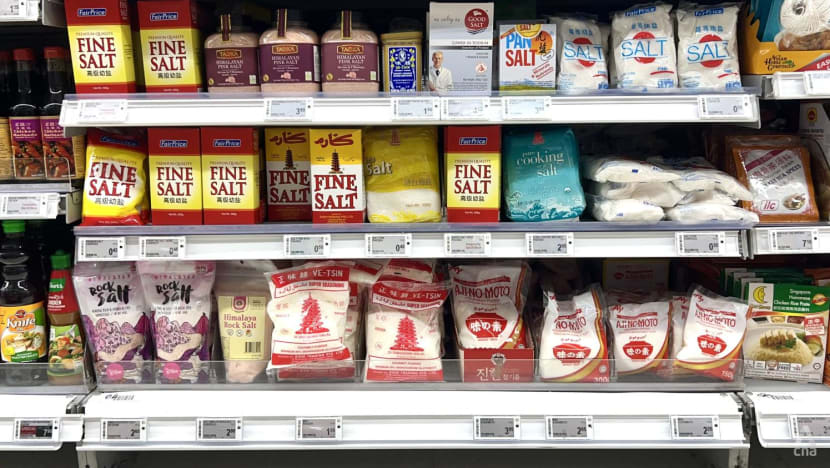15 manufacturers, food operators committed to increase variety, demand of lower-sodium alternatives
The wholesale price of most lower-sodium salt, sauces and seasonings supplied to food operators are comparable to that of the regular versions, said Senior Parliamentary Secretary for Health Rahayu Mahzam.

A selection of salts available at a supermarket in Singapore, including lower-sodium salt alternatives. (Photo: CNA/Ang Hwee Min)

This audio is generated by an AI tool.
SINGAPORE: Fifteen major manufacturers and food operators have committed to increasing the variety and demand of lower-sodium ingredients, as part of efforts to bring down excessive salt consumption in Singapore.
These manufacturers and food operators represent more than 30 per cent of the retail market for sauces and seasonings and 10 per cent of the food and beverage (F&B) market share, Senior Parliamentary Secretary for Health Rahayu Mahzam said in parliament on Monday (Nov 6).
Surveys by the Ministry of Health (MOH) and Health Promotion Board (HPB) released in September found that nine in 10 people in Singapore are consuming more salt than what is recommended.
The prevalence of hypertension or high blood pressure has also nearly doubled since 2010.
Member of Parliament Dr Lim Wee Kiak (PAP-Sembawang) had asked how the government intends to ensure that efforts to address sodium overconsumption do not inadvertently lead to increased business overhead costs and higher food prices.
On Monday, Ms Rahayu pointed out that HPB offers grant support to salt and sauce suppliers to reformulate their products through the Healthier Ingredient Development Scheme, which encourages the use of healthier ingredients in the food service industry.
Lower-sodium alternatives are now “more accessible” as a result and the wholesale price of most lower-sodium salt, sauces and seasonings supplied to food operators are comparable to that of the regular versions, Ms Rahayu said.
She added that the government will also need to explain to food operators such as hawkers, restaurants, caterers, and chefs on the need to cut salt intake, introduce them to lower-sodium ingredients, as well as provide them with samples to try out.
“We also hope that they will help us explain to the public that salt is an acquired taste and that if we over-consume it over some time, our taste buds will get accustomed to it and fail to taste other natural ingredients,” Ms Rahayu said, adding that the government is planning engagement sessions with food operators as well as their industry and professional associations.
She also noted that HPB will be stepping up its public education campaign. Last year, HPB encouraged people to switch from regular salt to lower-sodium alternatives.
“In Singapore, less salt often means more taste as it allows us to appreciate the natural flavours of the herbs, spices and other ingredients typically used in local cuisine,” said Ms Rahayu.
“HPB will continue to educate Singaporeans on the need to cut sodium, increase their receptiveness to using lower-sodium ingredients and change the perception that we need more salt and sauces for flavourful dishes,” she said, adding that the statutory board will conduct more activities, such as food sampling activities at supermarkets.
Singapore will tackle excessive sodium consumption in a way that is suited to its context. In many European and Western countries, their main source of sodium is processed foods which households buy from shops or supermarkets. In Singapore, sodium comes mainly from added salt, sauces and seasonings. A key priority is therefore to work with the manufacturers of salt and sauces. The Health Promotion Board (HPB) offers grant support to salt and sauce suppliers to reformulate their products through the Healthier Ingredient Development Scheme. As a result, there are now more lower-sodium alternatives. To date, 15 major manufacturers and food operators are working to increase the variety and demand of lower-sodium ingredients. They represent over 30 per cent of the retail market for sauces and seasonings and 10 per cent of the F&B market share. Senior Parliamentary Secretary for Health Rahayu Mahzam gave this update in reply to an MP’s questions in Parliament on Monday (Nov 6). She said the other stakeholders to engage are food operators such as hawkers, restaurants, caterers and chefs. HPB hopes that they can also help to explain to consumers that salt is an acquired taste and over-consumption will affect their taste of the natural ingredients. HPB is planning a series of engagement sessions with them, as well as stepping up its public education campaign and food sampling efforts to spread the message that less salt often means more taste of the natural flavours of the spices and other ingredients typically used in local cuisine.
NO INTENTION TO EMULATE SYSTEMS IN OTHER COUNTRIES
Dr Lim on Monday also asked for an update on the government’s study on sodium taxes in countries where such measures have been implemented, and when the recommendations on policy changes arising from this study will be put out.
In her parliamentary reply, Ms Rahayu cited examples of Chile, Finland and Hungary, which have implemented warning and food labels as well as taxes on salt and sugar respectively.
“These are useful practices for us to learn from, but we do not intend to emulate any of these systems.
“For example, our Nutri-grade labelling measures for pre-packaged beverages (have) been very effective in bringing down sugar consumption. We should likewise tackle excessive sodium consumption in a way that is suited to our context,” said Ms Rahayu.
She also noted the main source of sodium in European and Western countries is processed food which households buy from shops or supermarkets.
Meanwhile, in Singapore, sodium mainly comes from added salt, sauces and seasonings - such as soya sauce, dark sauce, fish sauce and chili sauce - and they are consumed the most when eating out, she added.
















